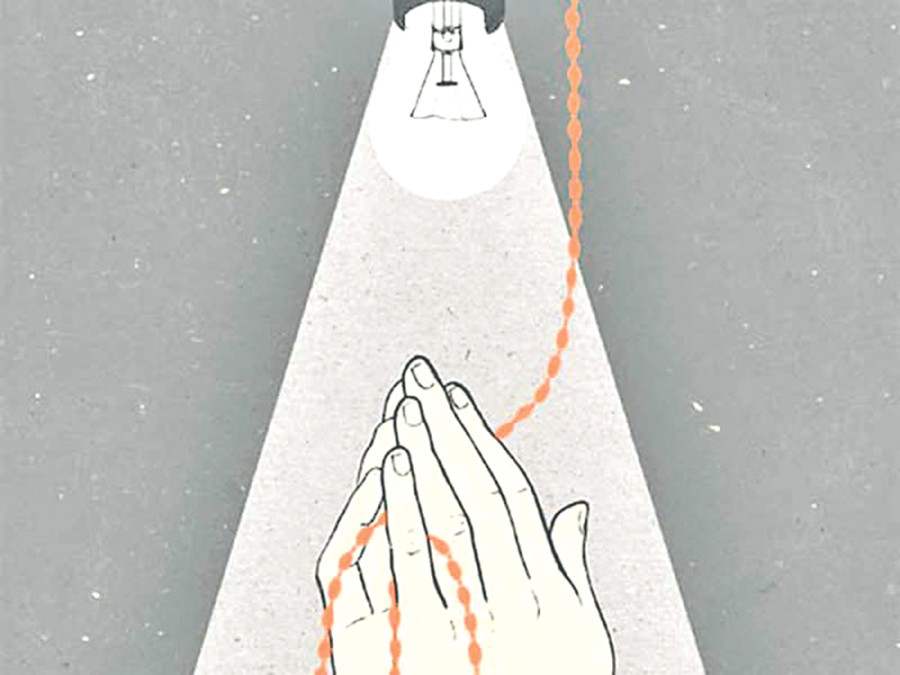Opinion
The cross they bear
Those concerned about religious conversion in Nepal should analyse properly why it is happening
Uddhab Pyakurel
Although Nepal was the only officially Hindu kingdom in the world until recently, many religions were practised in the country. According to the 2011 census, there are 10 different religions in Nepal. The country has now been declared secular, but voices in support of a Hindu kingdom still remain strong. Some even argue that secularism was the main cause of Indian displeasure with Nepal’s constitution promulgated last year. Those who have been advocating for Nepal to remain a Hindu state claim that religious conversions have been on the rise since the interim constitution of 2007 declared Nepal to be secular. Religious conversion to Christianity seems to be the main concern for many.
Six censuses
However, the argument that religious conversions have been on the rise only after Nepal was declared secular is flawed. To prove this, we need to go through the data on religion generated by the Nepal government in the past and compare the state of religious conversion before and after Nepal was declared a secular state.
Nepal first conducted a census in 1961, according to which there were only 458 Christians in the country. Then, the number of Christians increased significantly within 10 years and reached 2,546, according to the 1971 census, and 3,891 according to the 1981 census. The number of Christians in the country according to the following three censuses of 1991, 2001 and 2011 was 31,280, 101,976 and 375,699 respectively. The rate of growth of the number of Christians from the first census to the second was 455 percent, followed by 53 percent (from the second to the third), 704 percent (from the third to the fourth), 226 percent (from the fourth to the fifth) and 268 percent (from the fifth to the last one of 2011). Once we see the increments in the number of Christians during the Panchayat era—when Nepal was officially a Hindu Kingdom—and after the restoration of democracy in 1991, it is evident that in the 30-year period from 1960 to 1990, the annual increase in the number of Christians was 224 percent—the number increased by 67 times during the period. However, the Christian population increased just by 11 times—by 55 percent—during the 20-year period after the end of the Panchayat regime in 1990.
So it becomes clear that the number of Christians increased significantly even when Nepal was a Hindu state. In fact, it can be seen that the Panchyat era was a golden age for conversion to Christianity in Nepal. Thus the argument that the declaration of Nepal as a secular state encourages religious conversion does not hold much water: the official status of Nepal as a Hindu state or a secular one does not have much relation to religious conversion, especially from Hinduism to Christianity.
Reasons for conversion
After the dawn of democracy in Nepal in 1951, people belonging to the so-called lower castes became conscious of how Hindu religious practices discriminated against them. Untouchability was one such discriminatory practice that was severely humiliating to the Dalits—the then untouchable castes. Such discrimination pushed many to convert to Christianity, which treated them as equal human beings with respect to people of other castes. The decrease in the number of Hindus is also due to many Newar groups asserting themselves as Buddhists.
My talk with Gauri Bahadur Sunuwar, who also converted to Christianity, shed more light on why people convert. Sunuwar, originally from Rasnalu in Ramechhap but residing in Hattiban in Lalitpur since 1962, told me that his youngest son used to fall sick regularly. Some people told him that if one goes to church regularly, one could get rid of one’s illnesses. Strangely, after visiting a church regularly, his son did not have that health problem. With the belief that the visit to the church was the reason behind the cure, Sunuwar converted to Christianity from Hinduism in 1967.
There is no relation between better health and conversion to Christianity. Sunuwar’s reason is merely superstitious. However, while talking about some of the Hindu religious practices, I found Sunuwar’s argument very interesting. He said, “In the Hindu religion, if a member of your family dies, you have to observe Kriya (last rites) for at least 13 days without having proper food. The relatives cannot go to work to earn their bread and butter. How can people from poor families solve the problem of livelihood for all those 13 days? I felt that such practices in the Hindu religion were against poor people like us.” This was a valid point. Some of the Hindu religious practices can be very impractical, not only for the poor but everyone.
There are many underlying reasons that push people to convert to another religion. If some leaders are concerned about religious conversion from Hinduism to Christianity in Nepal, then they should properly analyse why it is happening. Maybe Hindu religious practices and belief system need to be altered as per the need of the time and its dehumanising practices corrected. Discrimination should end not only on paper but also in practice. Otherwise, simply lamenting about conversion to Christianity will not help even if Nepal reverts to Hinduism as its state religion.
Pyakurel teaches political sociology at Kathmandu University




 13.12°C Kathmandu
13.12°C Kathmandu










